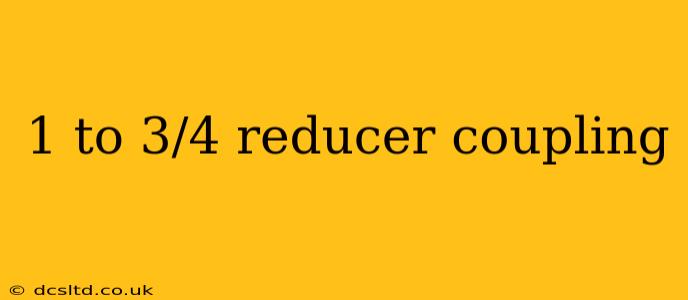Finding the right coupling is crucial for any plumbing or piping project. A 1 to 3/4 reducer coupling, in particular, presents a common need, bridging the gap between pipes of different diameters. This guide will comprehensively explore everything you need to know about these couplings, addressing common questions and concerns.
What is a 1 to 3/4 Reducer Coupling?
A 1 to 3/4 reducer coupling is a plumbing fitting designed to connect two pipes of differing diameters – specifically, a 1-inch pipe to a 3/4-inch pipe. It's essentially a connector that smoothly reduces the size of the pipe while maintaining a consistent flow. These couplings are vital for transitioning between pipe sizes in various applications, ensuring a seamless connection without leaks or disruptions. They come in various materials, each suited to specific needs and applications.
What are the Different Types of 1 to 3/4 Reducer Couplings?
Several types cater to various needs and applications:
-
Material: Common materials include brass, PVC, CPVC, and galvanized steel. Brass couplings offer excellent corrosion resistance, while PVC and CPVC are lightweight and corrosion-resistant, perfect for water supply lines. Galvanized steel provides strength and durability, often used in demanding industrial settings. The choice depends on the application, the type of fluid being transported, and the pressure involved.
-
Connection Type: These couplings can feature different connection methods: threaded (male/female), compression, or solvent weld. Threaded couplings are straightforward to install, requiring only a wrench. Compression fittings use compression rings and nuts to create a secure seal, offering quick and easy installation and removal. Solvent weld fittings are permanently bonded using a solvent cement, providing a strong and leak-proof connection—ideal for applications requiring high pressure and durability.
-
Reducer Type: Reducer couplings can be either concentric or eccentric. Concentric reducers maintain the center line of the pipe, while eccentric reducers offset the center line, useful for situations where maintaining consistent flow is paramount while adapting to different pipe levels.
What are the Applications of a 1 to 3/4 Reducer Coupling?
The applications of a 1 to 3/4 reducer coupling are diverse and span various industries:
- Plumbing: Commonly used in residential and commercial plumbing systems for connecting pipes of different sizes, often found in water supply lines and drainage systems.
- Irrigation: Used in irrigation systems to connect larger main lines to smaller branches or drip systems.
- Industrial Piping: Used extensively in various industrial processes to adapt pipe sizes in chemical plants, refineries, and manufacturing facilities.
- HVAC: Found in heating, ventilation, and air conditioning systems to connect pipes of various diameters.
How Do I Choose the Right 1 to 3/4 Reducer Coupling?
Selecting the correct coupling is crucial for a successful project. Factors to consider include:
- Pipe Material: Ensure compatibility between the coupling material and the pipes it connects.
- Pressure Rating: Choose a coupling with a pressure rating exceeding the maximum system pressure.
- Connection Type: Select the connection method best suited for your skill level and the specific application.
- Flow Requirements: If necessary, an eccentric reducer might be necessary to optimize flow.
Where Can I Buy a 1 to 3/4 Reducer Coupling?
1 to 3/4 reducer couplings are widely available at various retailers:
- Home Improvement Stores: Large home improvement chains typically stock a range of couplings.
- Plumbing Supply Stores: Specialized plumbing supply stores offer a wider selection and expertise in choosing the right fitting.
- Online Retailers: Many online retailers offer a convenient way to purchase couplings, often providing a broad selection and competitive prices.
What are the Potential Problems with a 1 to 3/4 Reducer Coupling?
While generally reliable, several issues might arise:
- Leaks: Improper installation is the most common cause of leaks. Ensure all connections are tight and sealed correctly. Using the appropriate sealant or thread tape is crucial.
- Material Degradation: Over time, materials can degrade due to corrosion or chemical exposure. Regular inspection is essential to identify any potential issues before they cause problems.
- Incorrect Sizing: Using an incorrectly sized coupling can lead to flow restrictions or structural weakness.
This comprehensive guide helps understand the various aspects of 1 to 3/4 reducer couplings. Remember to always consult professional advice when working with plumbing or piping systems, especially in high-pressure applications. Prioritize safety and ensure all work meets relevant codes and regulations.
